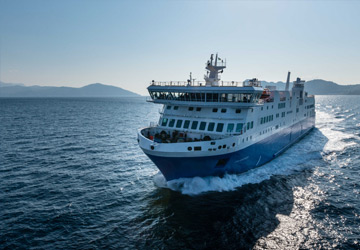
-
Recent Searches
Recent Searches
- Travel Alerts
- My Account
- Customer Service
-
United Kingdom
Travemunde to Malmo Ferry
The Travemunde Malmo ferry route connects Germany with Sweden. Currently there is just the 1 ferry company operating this ferry service, Finnlines. The crossing operates up to 19 times each week with sailing durations from around 8 hours 45 minutes.
Travemunde Malmo sailing durations and frequency may vary from season to season so we’d advise doing a live check to get the most up to date information.
Travemunde to Malmo Ferry Alternatives
-

-
Get price
-
-

-
Get price
-
-

-
Get price
-
-

-
Get price
-
Average Travemunde Malmo Prices
Prices shown represent the average one way price paid by our customers. The most common booking on the Travemunde Malmo route is a car and 2 passengers.
Travemunde Malmo Ferry reviews
-
"I would do it again!"
Everything was great!
'Nelli' travelled Travemunde Malmo with Finnlines
Read More Read Less -
"Ship was very cold"
Crossing was good value, saved road miles but throughout the trip we were cold. Blankets provided but the sight of people in coats, snuggled under blankets did not contribute to our summer holiday in June.
'Neville' travelled Travemunde Malmo with Finnlines
Read More Read Less -
"finlines trip to Malmo"
Wonderful operator. Comfy beds and an amazing buffet breakfast and a great price. Will definitely use again.
'Michael' travelled Travemunde Malmo with Finnlines
Read More Read Less -
"Cheapest way to travel to Sweden"
Very relaxed.It takes longer, but it's a fun way to travel. And even cheaper because of the tolls of danish bridges. Too bad you could not see the bridge.
'Johannes C' travelled Travemunde Malmo with Finnlines
Read More Read Less
Travemunde Guide
The German town of Travemunde is located in Lubeck and lies at the mouth of the River Trave in Lubeck Bay. Founded in the 12th century by Henry the Lion, Duke of Saxony, when he built a fortress to guard the mouth of the River Trave, the town was later improved by the Danes and became a town in 1317. The town is now the largest ferry port in Germany on the Baltic Sea and since the early 19th century it has been a popular tourist resort. Popular attractions in the town include its lighthouse which dates back to 1539 and is the oldest along the German Baltic Sea coast. Another is the museum ship, the Flying P-Liner Passat, which is anchored in the mouth of the River Trave. Motorised vehicles are prohibited from using the town's main street, Vorderreihe, and the coastal promenade. There are buses that run to the town and the connection point is the train station. Riding a bike or walking is usually preferable as most of the streets are narrow and often get congested with cars driven by inexperienced drivers.
Ferry services from the port depart to Sweden, Finland, Russia, Latvia and Estonia.
Malmo Guide
The Swedish city of Malmo seems to be centred around its Old Town which is known as the Gamla Staden and is bordered by a lovely canal. In this area there are three squares which are popular with tourists and are surrounded by shops and restaurants. The squares are named Stortorget (Big Square), Lilla Torg (Little Square) and Gustav Adolfs Torg (Gustav Adolfs Square). Other popular attractions in the city is the 15th century Malmo Castle, which is called Malmohus Slott by the locals, the City Hall which overlooks the Big Square and the Turning Torso, which is the tallest building in Scandinavia and is rather eye catching and according to some, bizarre. The city is also a great base from which to explore other parts of Sweden with many tourists choosing to take day trips outside of the city.
The city can trace its origins back to 1275 when it is thought to have been founded as a quay or ferry berth for the Archbishop of Lund.
Ferries from the port in Malmo depart to Travemunde in Germany.


